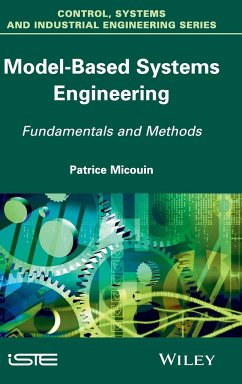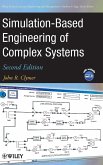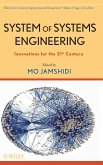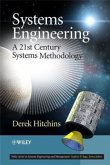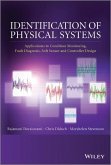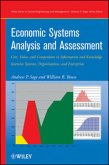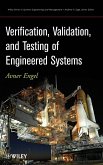- Gebundenes Buch
- Merkliste
- Auf die Merkliste
- Bewerten Bewerten
- Teilen
- Produkt teilen
- Produkterinnerung
- Produkterinnerung
This book is a contribution to the definition of a model based system engineering (MBSE) approach, designed to meet the objectives laid out by the INCOSE. After pointing out the complexity that jeopardizes a lot of system developments, the book examines fundamental aspects of systems under consideration. It goes on to address methodological issues and proposes a methodic approach of MBSE that provides, unlike current practices, systematic and integrated model-based engineering processes. An annex describes relevant features of the VHDL-AMS language supporting the methodological issues described in the book.…mehr
Andere Kunden interessierten sich auch für
![Simulation-Based Engineering of Complex Systems Simulation-Based Engineering of Complex Systems]() John R. ClymerSimulation-Based Engineering of Complex Systems204,99 €
John R. ClymerSimulation-Based Engineering of Complex Systems204,99 €![System of Systems Engineering System of Systems Engineering]() System of Systems Engineering192,99 €
System of Systems Engineering192,99 €![Systems Engineering Systems Engineering]() Derek K. HitchinsSystems Engineering184,99 €
Derek K. HitchinsSystems Engineering184,99 €![Managing and Engineering Complex Technological Systems Managing and Engineering Complex Technological Systems]() Avigdor ZonnenshainManaging and Engineering Complex Technological Systems145,99 €
Avigdor ZonnenshainManaging and Engineering Complex Technological Systems145,99 €![Identification of Physical Systems Identification of Physical Systems]() Rajamani DoraiswamiIdentification of Physical Systems139,99 €
Rajamani DoraiswamiIdentification of Physical Systems139,99 €![Economic Systems Analysis and Assessment Economic Systems Analysis and Assessment]() Andrew P. SageEconomic Systems Analysis and Assessment176,99 €
Andrew P. SageEconomic Systems Analysis and Assessment176,99 €![Verification, Validation, and Testing of Engineered Systems Verification, Validation, and Testing of Engineered Systems]() Avner EngelVerification, Validation, and Testing of Engineered Systems211,99 €
Avner EngelVerification, Validation, and Testing of Engineered Systems211,99 €-
-
-
This book is a contribution to the definition of a model based system engineering (MBSE) approach, designed to meet the objectives laid out by the INCOSE. After pointing out the complexity that jeopardizes a lot of system developments, the book examines fundamental aspects of systems under consideration. It goes on to address methodological issues and proposes a methodic approach of MBSE that provides, unlike current practices, systematic and integrated model-based engineering processes. An annex describes relevant features of the VHDL-AMS language supporting the methodological issues described in the book.
Hinweis: Dieser Artikel kann nur an eine deutsche Lieferadresse ausgeliefert werden.
Hinweis: Dieser Artikel kann nur an eine deutsche Lieferadresse ausgeliefert werden.
Produktdetails
- Produktdetails
- ISTE Focus
- Verlag: Wiley & Sons
- Artikelnr. des Verlages: 1W848214690
- 1. Auflage
- Seitenzahl: 306
- Erscheinungstermin: 22. September 2014
- Englisch
- Abmessung: 240mm x 161mm x 21mm
- Gewicht: 593g
- ISBN-13: 9781848214699
- ISBN-10: 1848214693
- Artikelnr.: 36935110
- Herstellerkennzeichnung
- Libri GmbH
- Europaallee 1
- 36244 Bad Hersfeld
- 06621 890
- ISTE Focus
- Verlag: Wiley & Sons
- Artikelnr. des Verlages: 1W848214690
- 1. Auflage
- Seitenzahl: 306
- Erscheinungstermin: 22. September 2014
- Englisch
- Abmessung: 240mm x 161mm x 21mm
- Gewicht: 593g
- ISBN-13: 9781848214699
- ISBN-10: 1848214693
- Artikelnr.: 36935110
- Herstellerkennzeichnung
- Libri GmbH
- Europaallee 1
- 36244 Bad Hersfeld
- 06621 890
Patrice Micouin is a consultant and researcher at Laboratoire des Sciences de l'Information et des Systèmes in Marseille, France, as well as Managing Partner at MICOUIN Consulting.
LIST OF FIGURES AND TABLE xi
ACKNOWLEDGEMENTS xvii
FOREWORD xxi
Dominique LUZEAUX
INTRODUCTION. GOALS OF PROPERTY
MODEL METHODOLOGY xxv
PART 1. FUNDAMENTALS 1
Chapter 1. General Systems Theory 3
1.1. Introduction 3
1.2. What is a system? 4
1.3. Systems, subsystems and levels 9
1.4. Concrete and abstract objects 11
1.5. Properties 12
1.5.1. Material and formal properties 12
1.5.2. Accidental and essential properties, laws and types 13
1.5.3. Dispositions, structural and behavioral properties 17
1.5.4. Resulting and emerging properties 18
1.6. States, event, process, behavior and fact 20
1.7. Systems of interest 23
CHAPTER 2. TECHNOLOGICAL SYSTEMS 25
2.1. Introduction 25
2.2. Definition of technological systems 25
2.2.1. Artificial autotelic and heterotelic systems 27
2.2.2. Technical-empirical and technological systems 27
2.2.3. Purpose of a technological system 28
2.3. Function, behavior and structure of a technological system 30
2.4. Intended and concomitant effects of a technological system 34
2.5. Modes, mode switching and states 36
2.5.1. Modes of operation 36
2.5.2. Mode switching 36
2.5.3. Operating states 37
2.6. Errors, faults and failures 37
2.7. "The human factor" 39
CHAPTER 3. KNOWLEDGE SYSTEMS 41
3.1. Introduction 41
3.2. Knowledge and its bearers 42
3.3. Intersubjective knowledge 44
3.4. Concepts, propositions and conceptual knowledge 45
3.5. Objective and true knowledge 47
3.6. Scientific and technological knowledge 50
3.6.1. Fundamental sciences 51
3.6.2. Applied sciences and technology 53
3.6.3. Operative technological rules 53
3.6.4. Substantive technological rules 55
3.7. Knowledge and belief 56
CHAPTER 4. SEMIOTIC SYSTEMS AND MODELS 59
4.1. Introduction 59
4.2. Signs and systems of signs 60
4.3. Nomological propositions and law statements 65
4.4. Models, object models, theoretical models and simulation 66
4.5. Representativeness of models and the expressiveness of languages 71
4.5.1. Representativeness of models 71
4.5.2. Expressiveness of a language 73
PART 2. METHODS 77
CHAPTER 5. ENGINEERING PROCESSES 79
5.1. Introduction 79
5.2. Systems engineering process 81
5.2.1. General framework 81
5.2.2. Design process 83
5.2.3. Safety assessment process 88
5.2.4. Requirement and assumption validation 90
5.2.5. Verification of the implementation regarding requirements 91
5.2.6. Managing configurations 92
5.2.7. Process (quality) assurance, certification and coordination with
authorities 93
CHAPTER 6. DETERMINING REQUIREMENTS AND SPECIFICATION MODELS 95
6.1. Introduction 95
6.2. Specifications and requirements 98
6.3. Text-based requirements and subjectivity 100
6.4. Objectifying requirements and assumptions through property-based
requirements 102
6.4.1. Definition 102
6.4.2. Examples 104
6.4.3. Typology and sources of PBR 106
6.5. Conjunction and comparison of property-based requirements 110
6.5.1. Comparison of two PBRs 111
6.5.2. Conjunction of two PBRs 112
6.6. Interpreting text-based requirements 114
6.6.1. Example 1: FAR29.1303(b) flight and navigation instruments 115
6.6.2. Example 2: FAR29.951(a) Fuel systems - General 119
6.7. Conclusion: specification models and concurrent assertions 121
CHAPTER 7. DESIGNING SOLUTIONS AND DESIGN MODELS 127
7.1. Introduction 127
7.2. Deriving requirements 128
7.3. Basic system model of a type of systems 131
7.4. Dynamic design models of a type of systems 133
7.4.1. Behavioral design model (BDM) 133
7.4.2. Equation-based design models (EDMs) 139
7.5. Derivation and allocation of the system's behavioral requirements 141
7.6. Static design models 142
7.6.1. Composite system model 142
7.6.2. Structural design model 145
7.6.3. Allocation of BDM components to SDM components 146
7.7. Derivation and allocation of system requirements 146
7.8. The end of the design process and the realization 148
CHAPTER 8. VALIDATING REQUIREMENTS AND ASSUMPTIONS 151
8.1. Introduction 151
8.2. The validation process according to the ARP4754A 152
8.2.1. Goal of the validation 152
8.2.2. Means of validation 154
8.3. The validation process according to the property model methodology 156
8.3.1. Goal of the validation 157
8.3.2. Means of validation 158
8.3.3. Exactness of a system specification model 160
8.3.4. Validating the derivation of system requirements 161
8.3.5. Scenarios and validation cases, efforts and rigor in validation 162
8.4. Conclusion 167
CHAPTER 9. VERIFYING THE IMPLEMENTATION STEP BY STEP 169
9.1. Introduction 169
9.2. The verification process according to the ARP4754A 170
9.2.1. Goal of the verification 170
9.2.2. Verification methods 170
9.3. The verification process according to the property model methodology
173
9.3.1. Objects to be verified 173
9.3.2. Goal of the verification 174
9.3.3. Verifying the design 175
9.3.4. Verifying the other products of implementation 179
9.3.5. The contract theorem 181
9.4. Conclusion 181
CHAPTER 10. SAFETY ENGINEERING 183
10.1. Introduction 183
10.2. The safety assessment process according to the ARP4754A 184
10.2.1. Goal of safety assessment process 184
10.2.2. Means to assess safety 185
10.3. The safety assessment process according to the property model
methodology (PMM) 191
10.3.1. Errors, faults and failures 191
10.3.2. FHA and interpretation of the 1309(b)(2)(i) requirements as PBRs
193
10.3.3. PASA/PSSA and deriving safety requirements 200
10.3.4. Simulation and validation of the derived safety requirements 204
10.3.5. Simulation and verification of the failure prevention mechanisms
206
10.3.6. Reliability design models 207
10.3.7. Safety theorem: validating additional requirements 208
10.4. Conclusion 211
CHAPTER 11. PROPERTY MODEL METHODOLOGY DEVELOPMENT PROCESS 213
11.1. Introduction 213
11.2. Early phase of a system development, preliminary studies 213
11.3. Steps of the industrial development of a type of systems 215
11.4. Initial step: highest level system specification 216
11.4.1. Initial step general approach 217
11.4.2. Establishing a specification model of the type of systems 218
11.5. Design steps: descending and iterative design of the building blocks
down to the lowest level blocks 226
11.5.1. Design step of a non-terminal block 227
11.5.2. Behavioral design step of a terminal block 229
11.5.3. End of the design step 231
11.6. Realization step of the lowest level building blocks 231
11.7. Integration and installation steps 232
11.8. Conclusion 233
APPENDIX 235
BIBLIOGRAPHY 253
INDEX 261
ACKNOWLEDGEMENTS xvii
FOREWORD xxi
Dominique LUZEAUX
INTRODUCTION. GOALS OF PROPERTY
MODEL METHODOLOGY xxv
PART 1. FUNDAMENTALS 1
Chapter 1. General Systems Theory 3
1.1. Introduction 3
1.2. What is a system? 4
1.3. Systems, subsystems and levels 9
1.4. Concrete and abstract objects 11
1.5. Properties 12
1.5.1. Material and formal properties 12
1.5.2. Accidental and essential properties, laws and types 13
1.5.3. Dispositions, structural and behavioral properties 17
1.5.4. Resulting and emerging properties 18
1.6. States, event, process, behavior and fact 20
1.7. Systems of interest 23
CHAPTER 2. TECHNOLOGICAL SYSTEMS 25
2.1. Introduction 25
2.2. Definition of technological systems 25
2.2.1. Artificial autotelic and heterotelic systems 27
2.2.2. Technical-empirical and technological systems 27
2.2.3. Purpose of a technological system 28
2.3. Function, behavior and structure of a technological system 30
2.4. Intended and concomitant effects of a technological system 34
2.5. Modes, mode switching and states 36
2.5.1. Modes of operation 36
2.5.2. Mode switching 36
2.5.3. Operating states 37
2.6. Errors, faults and failures 37
2.7. "The human factor" 39
CHAPTER 3. KNOWLEDGE SYSTEMS 41
3.1. Introduction 41
3.2. Knowledge and its bearers 42
3.3. Intersubjective knowledge 44
3.4. Concepts, propositions and conceptual knowledge 45
3.5. Objective and true knowledge 47
3.6. Scientific and technological knowledge 50
3.6.1. Fundamental sciences 51
3.6.2. Applied sciences and technology 53
3.6.3. Operative technological rules 53
3.6.4. Substantive technological rules 55
3.7. Knowledge and belief 56
CHAPTER 4. SEMIOTIC SYSTEMS AND MODELS 59
4.1. Introduction 59
4.2. Signs and systems of signs 60
4.3. Nomological propositions and law statements 65
4.4. Models, object models, theoretical models and simulation 66
4.5. Representativeness of models and the expressiveness of languages 71
4.5.1. Representativeness of models 71
4.5.2. Expressiveness of a language 73
PART 2. METHODS 77
CHAPTER 5. ENGINEERING PROCESSES 79
5.1. Introduction 79
5.2. Systems engineering process 81
5.2.1. General framework 81
5.2.2. Design process 83
5.2.3. Safety assessment process 88
5.2.4. Requirement and assumption validation 90
5.2.5. Verification of the implementation regarding requirements 91
5.2.6. Managing configurations 92
5.2.7. Process (quality) assurance, certification and coordination with
authorities 93
CHAPTER 6. DETERMINING REQUIREMENTS AND SPECIFICATION MODELS 95
6.1. Introduction 95
6.2. Specifications and requirements 98
6.3. Text-based requirements and subjectivity 100
6.4. Objectifying requirements and assumptions through property-based
requirements 102
6.4.1. Definition 102
6.4.2. Examples 104
6.4.3. Typology and sources of PBR 106
6.5. Conjunction and comparison of property-based requirements 110
6.5.1. Comparison of two PBRs 111
6.5.2. Conjunction of two PBRs 112
6.6. Interpreting text-based requirements 114
6.6.1. Example 1: FAR29.1303(b) flight and navigation instruments 115
6.6.2. Example 2: FAR29.951(a) Fuel systems - General 119
6.7. Conclusion: specification models and concurrent assertions 121
CHAPTER 7. DESIGNING SOLUTIONS AND DESIGN MODELS 127
7.1. Introduction 127
7.2. Deriving requirements 128
7.3. Basic system model of a type of systems 131
7.4. Dynamic design models of a type of systems 133
7.4.1. Behavioral design model (BDM) 133
7.4.2. Equation-based design models (EDMs) 139
7.5. Derivation and allocation of the system's behavioral requirements 141
7.6. Static design models 142
7.6.1. Composite system model 142
7.6.2. Structural design model 145
7.6.3. Allocation of BDM components to SDM components 146
7.7. Derivation and allocation of system requirements 146
7.8. The end of the design process and the realization 148
CHAPTER 8. VALIDATING REQUIREMENTS AND ASSUMPTIONS 151
8.1. Introduction 151
8.2. The validation process according to the ARP4754A 152
8.2.1. Goal of the validation 152
8.2.2. Means of validation 154
8.3. The validation process according to the property model methodology 156
8.3.1. Goal of the validation 157
8.3.2. Means of validation 158
8.3.3. Exactness of a system specification model 160
8.3.4. Validating the derivation of system requirements 161
8.3.5. Scenarios and validation cases, efforts and rigor in validation 162
8.4. Conclusion 167
CHAPTER 9. VERIFYING THE IMPLEMENTATION STEP BY STEP 169
9.1. Introduction 169
9.2. The verification process according to the ARP4754A 170
9.2.1. Goal of the verification 170
9.2.2. Verification methods 170
9.3. The verification process according to the property model methodology
173
9.3.1. Objects to be verified 173
9.3.2. Goal of the verification 174
9.3.3. Verifying the design 175
9.3.4. Verifying the other products of implementation 179
9.3.5. The contract theorem 181
9.4. Conclusion 181
CHAPTER 10. SAFETY ENGINEERING 183
10.1. Introduction 183
10.2. The safety assessment process according to the ARP4754A 184
10.2.1. Goal of safety assessment process 184
10.2.2. Means to assess safety 185
10.3. The safety assessment process according to the property model
methodology (PMM) 191
10.3.1. Errors, faults and failures 191
10.3.2. FHA and interpretation of the 1309(b)(2)(i) requirements as PBRs
193
10.3.3. PASA/PSSA and deriving safety requirements 200
10.3.4. Simulation and validation of the derived safety requirements 204
10.3.5. Simulation and verification of the failure prevention mechanisms
206
10.3.6. Reliability design models 207
10.3.7. Safety theorem: validating additional requirements 208
10.4. Conclusion 211
CHAPTER 11. PROPERTY MODEL METHODOLOGY DEVELOPMENT PROCESS 213
11.1. Introduction 213
11.2. Early phase of a system development, preliminary studies 213
11.3. Steps of the industrial development of a type of systems 215
11.4. Initial step: highest level system specification 216
11.4.1. Initial step general approach 217
11.4.2. Establishing a specification model of the type of systems 218
11.5. Design steps: descending and iterative design of the building blocks
down to the lowest level blocks 226
11.5.1. Design step of a non-terminal block 227
11.5.2. Behavioral design step of a terminal block 229
11.5.3. End of the design step 231
11.6. Realization step of the lowest level building blocks 231
11.7. Integration and installation steps 232
11.8. Conclusion 233
APPENDIX 235
BIBLIOGRAPHY 253
INDEX 261
LIST OF FIGURES AND TABLE xi
ACKNOWLEDGEMENTS xvii
FOREWORD xxi
Dominique LUZEAUX
INTRODUCTION. GOALS OF PROPERTY
MODEL METHODOLOGY xxv
PART 1. FUNDAMENTALS 1
Chapter 1. General Systems Theory 3
1.1. Introduction 3
1.2. What is a system? 4
1.3. Systems, subsystems and levels 9
1.4. Concrete and abstract objects 11
1.5. Properties 12
1.5.1. Material and formal properties 12
1.5.2. Accidental and essential properties, laws and types 13
1.5.3. Dispositions, structural and behavioral properties 17
1.5.4. Resulting and emerging properties 18
1.6. States, event, process, behavior and fact 20
1.7. Systems of interest 23
CHAPTER 2. TECHNOLOGICAL SYSTEMS 25
2.1. Introduction 25
2.2. Definition of technological systems 25
2.2.1. Artificial autotelic and heterotelic systems 27
2.2.2. Technical-empirical and technological systems 27
2.2.3. Purpose of a technological system 28
2.3. Function, behavior and structure of a technological system 30
2.4. Intended and concomitant effects of a technological system 34
2.5. Modes, mode switching and states 36
2.5.1. Modes of operation 36
2.5.2. Mode switching 36
2.5.3. Operating states 37
2.6. Errors, faults and failures 37
2.7. "The human factor" 39
CHAPTER 3. KNOWLEDGE SYSTEMS 41
3.1. Introduction 41
3.2. Knowledge and its bearers 42
3.3. Intersubjective knowledge 44
3.4. Concepts, propositions and conceptual knowledge 45
3.5. Objective and true knowledge 47
3.6. Scientific and technological knowledge 50
3.6.1. Fundamental sciences 51
3.6.2. Applied sciences and technology 53
3.6.3. Operative technological rules 53
3.6.4. Substantive technological rules 55
3.7. Knowledge and belief 56
CHAPTER 4. SEMIOTIC SYSTEMS AND MODELS 59
4.1. Introduction 59
4.2. Signs and systems of signs 60
4.3. Nomological propositions and law statements 65
4.4. Models, object models, theoretical models and simulation 66
4.5. Representativeness of models and the expressiveness of languages 71
4.5.1. Representativeness of models 71
4.5.2. Expressiveness of a language 73
PART 2. METHODS 77
CHAPTER 5. ENGINEERING PROCESSES 79
5.1. Introduction 79
5.2. Systems engineering process 81
5.2.1. General framework 81
5.2.2. Design process 83
5.2.3. Safety assessment process 88
5.2.4. Requirement and assumption validation 90
5.2.5. Verification of the implementation regarding requirements 91
5.2.6. Managing configurations 92
5.2.7. Process (quality) assurance, certification and coordination with
authorities 93
CHAPTER 6. DETERMINING REQUIREMENTS AND SPECIFICATION MODELS 95
6.1. Introduction 95
6.2. Specifications and requirements 98
6.3. Text-based requirements and subjectivity 100
6.4. Objectifying requirements and assumptions through property-based
requirements 102
6.4.1. Definition 102
6.4.2. Examples 104
6.4.3. Typology and sources of PBR 106
6.5. Conjunction and comparison of property-based requirements 110
6.5.1. Comparison of two PBRs 111
6.5.2. Conjunction of two PBRs 112
6.6. Interpreting text-based requirements 114
6.6.1. Example 1: FAR29.1303(b) flight and navigation instruments 115
6.6.2. Example 2: FAR29.951(a) Fuel systems - General 119
6.7. Conclusion: specification models and concurrent assertions 121
CHAPTER 7. DESIGNING SOLUTIONS AND DESIGN MODELS 127
7.1. Introduction 127
7.2. Deriving requirements 128
7.3. Basic system model of a type of systems 131
7.4. Dynamic design models of a type of systems 133
7.4.1. Behavioral design model (BDM) 133
7.4.2. Equation-based design models (EDMs) 139
7.5. Derivation and allocation of the system's behavioral requirements 141
7.6. Static design models 142
7.6.1. Composite system model 142
7.6.2. Structural design model 145
7.6.3. Allocation of BDM components to SDM components 146
7.7. Derivation and allocation of system requirements 146
7.8. The end of the design process and the realization 148
CHAPTER 8. VALIDATING REQUIREMENTS AND ASSUMPTIONS 151
8.1. Introduction 151
8.2. The validation process according to the ARP4754A 152
8.2.1. Goal of the validation 152
8.2.2. Means of validation 154
8.3. The validation process according to the property model methodology 156
8.3.1. Goal of the validation 157
8.3.2. Means of validation 158
8.3.3. Exactness of a system specification model 160
8.3.4. Validating the derivation of system requirements 161
8.3.5. Scenarios and validation cases, efforts and rigor in validation 162
8.4. Conclusion 167
CHAPTER 9. VERIFYING THE IMPLEMENTATION STEP BY STEP 169
9.1. Introduction 169
9.2. The verification process according to the ARP4754A 170
9.2.1. Goal of the verification 170
9.2.2. Verification methods 170
9.3. The verification process according to the property model methodology
173
9.3.1. Objects to be verified 173
9.3.2. Goal of the verification 174
9.3.3. Verifying the design 175
9.3.4. Verifying the other products of implementation 179
9.3.5. The contract theorem 181
9.4. Conclusion 181
CHAPTER 10. SAFETY ENGINEERING 183
10.1. Introduction 183
10.2. The safety assessment process according to the ARP4754A 184
10.2.1. Goal of safety assessment process 184
10.2.2. Means to assess safety 185
10.3. The safety assessment process according to the property model
methodology (PMM) 191
10.3.1. Errors, faults and failures 191
10.3.2. FHA and interpretation of the 1309(b)(2)(i) requirements as PBRs
193
10.3.3. PASA/PSSA and deriving safety requirements 200
10.3.4. Simulation and validation of the derived safety requirements 204
10.3.5. Simulation and verification of the failure prevention mechanisms
206
10.3.6. Reliability design models 207
10.3.7. Safety theorem: validating additional requirements 208
10.4. Conclusion 211
CHAPTER 11. PROPERTY MODEL METHODOLOGY DEVELOPMENT PROCESS 213
11.1. Introduction 213
11.2. Early phase of a system development, preliminary studies 213
11.3. Steps of the industrial development of a type of systems 215
11.4. Initial step: highest level system specification 216
11.4.1. Initial step general approach 217
11.4.2. Establishing a specification model of the type of systems 218
11.5. Design steps: descending and iterative design of the building blocks
down to the lowest level blocks 226
11.5.1. Design step of a non-terminal block 227
11.5.2. Behavioral design step of a terminal block 229
11.5.3. End of the design step 231
11.6. Realization step of the lowest level building blocks 231
11.7. Integration and installation steps 232
11.8. Conclusion 233
APPENDIX 235
BIBLIOGRAPHY 253
INDEX 261
ACKNOWLEDGEMENTS xvii
FOREWORD xxi
Dominique LUZEAUX
INTRODUCTION. GOALS OF PROPERTY
MODEL METHODOLOGY xxv
PART 1. FUNDAMENTALS 1
Chapter 1. General Systems Theory 3
1.1. Introduction 3
1.2. What is a system? 4
1.3. Systems, subsystems and levels 9
1.4. Concrete and abstract objects 11
1.5. Properties 12
1.5.1. Material and formal properties 12
1.5.2. Accidental and essential properties, laws and types 13
1.5.3. Dispositions, structural and behavioral properties 17
1.5.4. Resulting and emerging properties 18
1.6. States, event, process, behavior and fact 20
1.7. Systems of interest 23
CHAPTER 2. TECHNOLOGICAL SYSTEMS 25
2.1. Introduction 25
2.2. Definition of technological systems 25
2.2.1. Artificial autotelic and heterotelic systems 27
2.2.2. Technical-empirical and technological systems 27
2.2.3. Purpose of a technological system 28
2.3. Function, behavior and structure of a technological system 30
2.4. Intended and concomitant effects of a technological system 34
2.5. Modes, mode switching and states 36
2.5.1. Modes of operation 36
2.5.2. Mode switching 36
2.5.3. Operating states 37
2.6. Errors, faults and failures 37
2.7. "The human factor" 39
CHAPTER 3. KNOWLEDGE SYSTEMS 41
3.1. Introduction 41
3.2. Knowledge and its bearers 42
3.3. Intersubjective knowledge 44
3.4. Concepts, propositions and conceptual knowledge 45
3.5. Objective and true knowledge 47
3.6. Scientific and technological knowledge 50
3.6.1. Fundamental sciences 51
3.6.2. Applied sciences and technology 53
3.6.3. Operative technological rules 53
3.6.4. Substantive technological rules 55
3.7. Knowledge and belief 56
CHAPTER 4. SEMIOTIC SYSTEMS AND MODELS 59
4.1. Introduction 59
4.2. Signs and systems of signs 60
4.3. Nomological propositions and law statements 65
4.4. Models, object models, theoretical models and simulation 66
4.5. Representativeness of models and the expressiveness of languages 71
4.5.1. Representativeness of models 71
4.5.2. Expressiveness of a language 73
PART 2. METHODS 77
CHAPTER 5. ENGINEERING PROCESSES 79
5.1. Introduction 79
5.2. Systems engineering process 81
5.2.1. General framework 81
5.2.2. Design process 83
5.2.3. Safety assessment process 88
5.2.4. Requirement and assumption validation 90
5.2.5. Verification of the implementation regarding requirements 91
5.2.6. Managing configurations 92
5.2.7. Process (quality) assurance, certification and coordination with
authorities 93
CHAPTER 6. DETERMINING REQUIREMENTS AND SPECIFICATION MODELS 95
6.1. Introduction 95
6.2. Specifications and requirements 98
6.3. Text-based requirements and subjectivity 100
6.4. Objectifying requirements and assumptions through property-based
requirements 102
6.4.1. Definition 102
6.4.2. Examples 104
6.4.3. Typology and sources of PBR 106
6.5. Conjunction and comparison of property-based requirements 110
6.5.1. Comparison of two PBRs 111
6.5.2. Conjunction of two PBRs 112
6.6. Interpreting text-based requirements 114
6.6.1. Example 1: FAR29.1303(b) flight and navigation instruments 115
6.6.2. Example 2: FAR29.951(a) Fuel systems - General 119
6.7. Conclusion: specification models and concurrent assertions 121
CHAPTER 7. DESIGNING SOLUTIONS AND DESIGN MODELS 127
7.1. Introduction 127
7.2. Deriving requirements 128
7.3. Basic system model of a type of systems 131
7.4. Dynamic design models of a type of systems 133
7.4.1. Behavioral design model (BDM) 133
7.4.2. Equation-based design models (EDMs) 139
7.5. Derivation and allocation of the system's behavioral requirements 141
7.6. Static design models 142
7.6.1. Composite system model 142
7.6.2. Structural design model 145
7.6.3. Allocation of BDM components to SDM components 146
7.7. Derivation and allocation of system requirements 146
7.8. The end of the design process and the realization 148
CHAPTER 8. VALIDATING REQUIREMENTS AND ASSUMPTIONS 151
8.1. Introduction 151
8.2. The validation process according to the ARP4754A 152
8.2.1. Goal of the validation 152
8.2.2. Means of validation 154
8.3. The validation process according to the property model methodology 156
8.3.1. Goal of the validation 157
8.3.2. Means of validation 158
8.3.3. Exactness of a system specification model 160
8.3.4. Validating the derivation of system requirements 161
8.3.5. Scenarios and validation cases, efforts and rigor in validation 162
8.4. Conclusion 167
CHAPTER 9. VERIFYING THE IMPLEMENTATION STEP BY STEP 169
9.1. Introduction 169
9.2. The verification process according to the ARP4754A 170
9.2.1. Goal of the verification 170
9.2.2. Verification methods 170
9.3. The verification process according to the property model methodology
173
9.3.1. Objects to be verified 173
9.3.2. Goal of the verification 174
9.3.3. Verifying the design 175
9.3.4. Verifying the other products of implementation 179
9.3.5. The contract theorem 181
9.4. Conclusion 181
CHAPTER 10. SAFETY ENGINEERING 183
10.1. Introduction 183
10.2. The safety assessment process according to the ARP4754A 184
10.2.1. Goal of safety assessment process 184
10.2.2. Means to assess safety 185
10.3. The safety assessment process according to the property model
methodology (PMM) 191
10.3.1. Errors, faults and failures 191
10.3.2. FHA and interpretation of the 1309(b)(2)(i) requirements as PBRs
193
10.3.3. PASA/PSSA and deriving safety requirements 200
10.3.4. Simulation and validation of the derived safety requirements 204
10.3.5. Simulation and verification of the failure prevention mechanisms
206
10.3.6. Reliability design models 207
10.3.7. Safety theorem: validating additional requirements 208
10.4. Conclusion 211
CHAPTER 11. PROPERTY MODEL METHODOLOGY DEVELOPMENT PROCESS 213
11.1. Introduction 213
11.2. Early phase of a system development, preliminary studies 213
11.3. Steps of the industrial development of a type of systems 215
11.4. Initial step: highest level system specification 216
11.4.1. Initial step general approach 217
11.4.2. Establishing a specification model of the type of systems 218
11.5. Design steps: descending and iterative design of the building blocks
down to the lowest level blocks 226
11.5.1. Design step of a non-terminal block 227
11.5.2. Behavioral design step of a terminal block 229
11.5.3. End of the design step 231
11.6. Realization step of the lowest level building blocks 231
11.7. Integration and installation steps 232
11.8. Conclusion 233
APPENDIX 235
BIBLIOGRAPHY 253
INDEX 261

